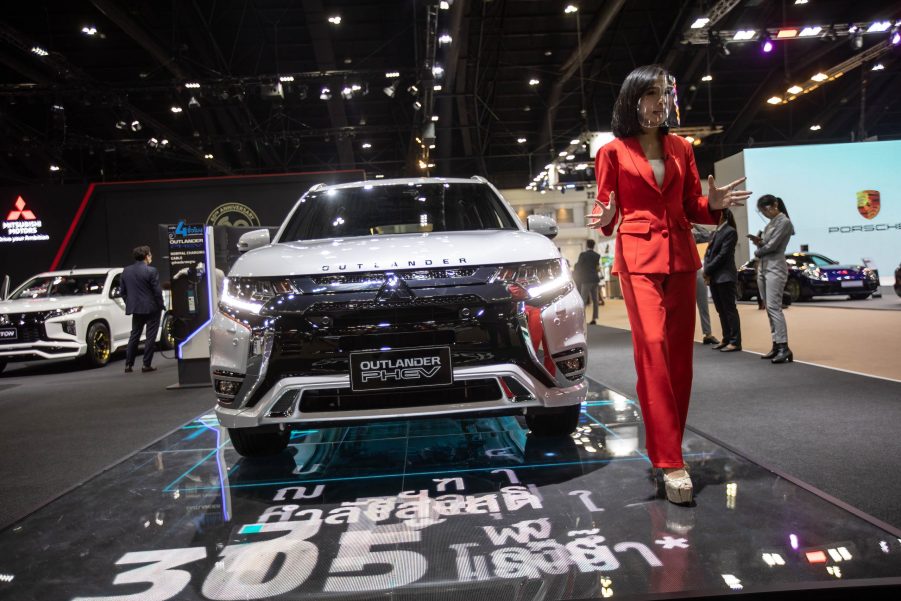
The 2021 Mitsubishi Outlander PHEV Has 1 Big Advantage Over Its Competition
Recent editions of the Mitsubishi Outlander had their fair share of issues, but the 2021 Mitsubishi Outlander PHEV is a step in the right direction. The vehicle serves as a good entryway for those interested in an electric car. Its feature set is solid if a little outdated in some areas, and its price is in line with similar cars. The electric car market is only growing with time, and the other available options are worth considering, including one from Mitsubishi itself.
Mitsubishi has struggled to make the Outlander a serviceable product for a few years
The Mitsubishi Outlander has not always been associated with quality since entering the market in 2017. Just last year, over 177,000 vehicles were recalled by the company due to issues surrounding faulty seatbelts (customers complained about this problem for years before it was finally fixed). The models involved in the recall were the 2014 through 2019 versions of the Outlander and the 2018 through 2019 Mitsubishi Outlander PHEV.
The car was not popular or highly regarded enough to shrug off this situation as a speed bump. The 2020 Outlander saw some improvements, but Mitsubishi had to make significant upgrades to get the line back on track and make it more appealing.
The 2021 version is unspectacular but dependable

The 2021 Mitsubishi Outlander PHEV includes a number of new features and upgrades to bring the vehicle up to par with competing SUVs. The electric-only range increases from 22 miles to 24 miles, and an additional 31 hp is also added. In most instances, the SUV is powered by its two electric motors, and the four-cylinder, 2.4-liter engine tends to power the generator.
The extended electric range comes courtesy of a battery pack that has 13.8 kWh, a step up from the 12 kWh that was in previous versions. The Outlander PHEV is generally limited to 174 hp, but when driving at higher speeds the engine will directly power the front wheels and increase the output to 221 hp.
The Outlander PHEV can be driven in Eco, Save, Charge, Normal, and Sport modes that give the driver more options to deal with the amount of fuel in the tank, the status of the battery, or if you’re driving through a fuel-only or electric-only location.
When you do need to charge the battery, it’s good to know that the Outlander is one of the few PHEVs that is capable of using quick chargers. It can go from empty to 80 percent charged by a Level 3 CHAdeMO fast charger in as little as 25 minutes. A 240-volt Level 2 charger will take four hours to fully replenish the battery pack, and a standard 120-volt household plug will take nine or 14 hours depending on if you have a 12 or eight-amp circuit. This is a major leg up compared to other competitors that take longer to recharge the battery back to full.
On the downside, the Outlander PHEV’s interior is dated, full of cheap plastic and clunky technology that has been surpassed in other vehicles. The SUV also doesn’t drive smoothly on bumpier roads, and it rolls through turns more than you would like. But overall, the Outlander is a decent enough SUV.
The base Outlander PHEV starts at $37,490 and the newly added mid-grade LE at $39,190, while range-topping GTs like the one we tested command $43,805, according to MotorTrend.
The 2022 model has even more impressive updates
The 2022 Mitsubishi Outlander PHEV continues the upward trajectory for Mitsubishi’s SUV. Next year’s edition of the vehicle has received some early praise from Consumer Reports. Due to the Nissan-Renault-Mitsubishi Alliance, the car has a lot in common with the 2021 Nissan Rogue, and the new Outlander uses that shared information for the better. It adds a third, admittedly smaller row, a more aesthetically pleasing cabin, and improves on the handling agility.
Mitsubishi has come a long way to make the Outlander a car worth taking out on the open road.


